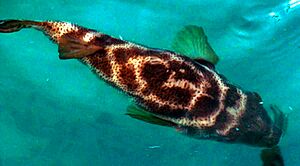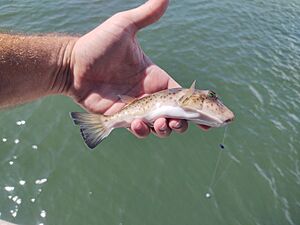Bullseye puffer facts for kids
Quick facts for kids Bullseye puffer |
|
|---|---|
 |
|
| Swimming near Galápagos Islands | |
| Scientific classification |
The bullseye puffer (scientific name: Sphoeroides annulatus) is a type of fish that belongs to the Tetraodontidae family. This family is also known as the pufferfishes. You can find the bullseye puffer in the eastern Pacific Ocean. Its home stretches from California, USA, all the way down to Pisco, Peru. It also lives around the Galápagos Islands.
Contents
- Where the Bullseye Puffer Lives
- Bullseye Puffer Homes
- What the Bullseye Puffer Looks Like
- How Bullseye Puffers Grow
- Bullseye Puffer Reproduction
- How Long Bullseye Puffers Live
- Bullseye Puffer Behavior
- What Bullseye Puffers Eat
- Who Eats the Bullseye Puffer
- Bullseye Puffer's Role in Nature
- Why Bullseye Puffers Are Important to People
- Bullseye Puffer's Safety Status
Where the Bullseye Puffer Lives
There are 23 different kinds of pufferfish in the Sphoeroides group around the world. Eleven of these live in Mexican waters. Six are found in the Atlantic Ocean, and five are in the Pacific Ocean. The bullseye puffer lives along the eastern Pacific Ocean. This includes the coasts from southern California, USA, to Peru. It also lives in the Gulf of California and near the Galápagos Islands.
Bullseye Puffer Homes
Bullseye puffers like to live over sandy areas on the ocean floor. Sometimes, they are found near rocky reefs with sandy spots nearby. They use their surroundings to hide from animals that might want to eat them. These fish usually live in shallow water. However, they have been seen as deep as 70 meters (about 230 feet). They prefer warm waters, usually around 25.8 degrees Celsius (78.4 degrees Fahrenheit).
What the Bullseye Puffer Looks Like
The bullseye puffer has a body that is a bit long and not too wide. Its back is an olive-brown color. Its belly is flat and white. On its head and back, you can see thin yellowish lines and bands. It also has three narrow bands right behind its eyes.
A special mark on its back looks like a "bullseye." This is a double oval shape. But on older, bigger fish, this mark might be hard to see. Its head, sides, and upper back have many small dark spots. The fish has yellow eyes and fins without any spots.
Its head is big, sticks out, and is blunt. The space between its eyes is wide and rounded. Bullseye puffers have strong teeth. Their top (dorsal) and bottom (anal) fins are small. They have 6 to 9 rays and are located far back on their body. The anal fin is just a little behind the dorsal fin. Their tail fin is rounded. They do not have pelvic fins. Their head and body are covered with small spines. Their skin is smooth and has no scales. These fish can grow up to 48 centimeters (about 19 inches) long.
How Bullseye Puffers Grow
After bullseye puffer eggs hatch, their insides start to grow. Their gut and liver begin to form on the first day. The pancreas develops next. After four days, their mouth opens. This is when they start eating tiny organisms called rotifers. It takes about two to three years for these fish to reach their full size.
Bullseye Puffer Reproduction
When bullseye puffers are young, they often live in fresh water. As they get older, they move to water that is a mix of fresh and salt (brackish) or full salt water. Scientists have learned how to raise young bullseye puffers in special farms. This is important for growing many fish to supply fish farms. Other types of Sphoeroides fish lay their eggs between May and August. They do this in shallow sandy or muddy water. Male puffers of a similar species, Sphoeroides maculatus, protect the eggs until they hatch.
How Long Bullseye Puffers Live
We don't know much about how long bullseye puffers live specifically. However, other pufferfish species can live for about ten years. This depends on the specific type of puffer and where it lives.
Bullseye Puffer Behavior
Bullseye puffers are very good at blending in with their surroundings. This helps them hide. Unlike some other pufferfish, they might not be able to puff themselves up to scare off predators. It is very important to know that bullseye puffers are highly poisonous if eaten. This is because they can have strong poisons called saxitoxin or tetrodotoxin. These poisons can be deadly.
What Bullseye Puffers Eat
Bullseye puffers can eat food particles floating on the water's surface. They also eat particles sinking in the water. And they can pick up food resting on the bottom. In the wild, these fish eat insects, crustaceans (like crabs and shrimp), and small fish. They use their strong, beak-like mouth to open shellfish and eat them.
Who Eats the Bullseye Puffer
Sharks are not affected by the poisons in bullseye puffers. Sharks are a main predator of pufferfish. Other large fish and sea snakes also eat them. Humans can also be predators. However, if humans eat them, they must avoid the ovaries and liver. These parts contain the dangerous poisons. Bullseye puffers use their colors and patterns to hide from predators. They blend in with coral reefs and sandy bottoms.
Bullseye Puffer's Role in Nature
We don't know a lot about the bullseye puffer's exact role in the ocean's ecosystem. However, Sphoeroides fish, like the bullseye puffer, eat insects, crustaceans, and small fish in shallow waters. Young puffers are often found in mangrove forests and estuaries. These are places where rivers meet the sea.
Why Bullseye Puffers Are Important to People
The bullseye puffer is quite valuable in the market. It can sell for about $11 per kilogram in the US. This fish has no scales and very few bones. People really like its meat because it is good quality. The demand for it is growing. The bullseye puffer is one of the top five most important fish caught by value and amount in some areas. Mexico is the second-largest exporter of pufferfish, sending out about 600 tons each year.
Bullseye Puffer's Safety Status
The bullseye puffer is currently considered to be of "least concern" for its safety. This means its population is stable and spread out widely. Fishermen often catch them with hooks and lines off the beaches of Baja California Sur. Divers also see them often in the water. The biggest threat to these fish is losing their homes.


